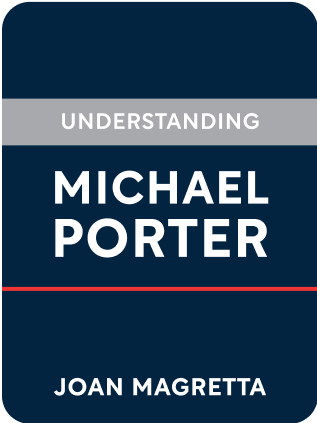

This article is an excerpt from the Shortform summary of "Understanding Michael Porter" by Joan Magretta. Shortform has the world's best summaries of books you should be reading.
Like this article? Sign up for a free trial here .
Are you looking for information on understanding Porter’s Five Forces?
Understanding Porter’s Five Forces is one way to develop a business model that works. With an improved understanding of Porter’s Five Forces, you can conduct industry analyses and build strong business strategies. Here’s a guide to the Five Forces.
What is Competition?
Part of understanding Porter’s Five Forces is knowing what competition is, and how competition is decided.
Aim to be unique, not the “best.” Create unique value, don’t focus on just beating rivals. There is no “best” in any industry, just like there is no “best performance artist.” There are different buyer needs, and there can be multiple winners.
For example, McDonald’s is a winner in fast food and fast burgers. But In-N-Out deliberately focuses on slow burgers, with non-processed meat and fresher ingredients. Both are winners in their own right. They’re each playing their own sport.
Competition is about profits, not market share. There is no glory in growth if it’s profitless.
Understanding Porter’s Five Forces
Why are some industries consistently more profitable than others? What makes information technology so stereotypically profitable, while airlines are a cutthroat, low-margin grind?
This is all part of understanding Porter’s Five Forces. The Five Forces that matter in any industry are:
- Buyers
- Suppliers
- Substitutes
- Incumbents
- New entrants
The more powerful the force, the more pressure it will put on decreasing prices or increasing costs, or both.
Understanding Porter’s Five Forces and Strategy
A distinctive value proposition, and a tailored value chain to deliver it, are the foundation of strategy. Your activities need to be different from rivals to have a meaningful strategic difference. As you work on understanding Porter’s Five Forces, you’ll learn how and why strategy works.
If you have a real competitive advantage, compared with rivals, you operate at a lower cost, command a premium price, or both. A good strategy is a set of activities that achieves competitive advantage.
A good strategy should pass five tests:
- Is there a distinctive value proposition?
- Is there a unique set of activities?
- Are the trade-offs different from rivals?
- Do the activities fit with each other?
- Is there continuity over time?
A good strategy delivers distinctive value through a distinctive value chain. It must perform different activities from rivals, or perform similar activities in different ways.
If the activities reinforce each other, imitating them all is difficult. If they involve trade-offs, your activities may contradict those of competitors, making it difficult for them to plunge in.
In one sense, strategy is choosing what not to do.
Don’t feel you have to make every customer happy. Trying to be something for everyone means you’re nothing to everyone. Make some customers unhappy.
Define what your company will not do. This is as important as defining what your company will do. Trade-offs make competitive advantage sustainable – rivals with different value chains will find it difficult to adopt your activities.
Instead of a single core competence, think of an interconnected web of activities that reinforce each other. This makes replication much more difficult.
- Read the full summary for descriptions of the master strategies of IKEA and Southwest Airlines, and how their activities reinforce each other to produce a large competitive advantage.
Strategy does not require heroic predictions about the future. All you need is a bet that your customers and needs will be robust for years.
- setting different prices for the same seat based on when someone bought a ticket. This may have seemed like smart price segmentation, but it trained customers to shop for prices.
- Rivalry among competitors is fierce. Empty seats are perishable goods, leading to price competition to make sure planes fly empty as little as possible.
- New entrants have a lower barrier than it seems – one can start an airline by leasing planes instead of buying them. Failed airlines have extra planes leading to excess capacity.
- Substitutes for travel like car, bus, and train keep prices down.
Understanding Porter’s Five Forces: Steps in Industry Analysis
The Five Forces are used to study the profitability of any industry. Michael Porter outlines the process on how to apply them to analyze an industry. Understanding Porter’s Five Forces will allow you to accurately conduct an industry analysis.
1. Define the industry by its product scope and geographic scope.
- Rule of thumb: Where there are large differences in forces, you are likely dealing with distinct industries. Each industry will need its own strategy.
- Product scope
- Motor oil used in consumer cars is different from those used in trucks. The latter involve corporate buyers and use different selling channels.
- Geographic scope: global, national, regional
- Buyers may be very different across geographies, even with the same product.
2. Identify the players comprising each of the Five Forces. Segment them into groups.
3. Understand the drivers of each force. Which are strong? Which are weak? Why?
4. Step back and understand the industry as a whole.
- Which forces determine profitability? Rarely are all five forces equally balanced.
- Where are the more profitable companies positioned in relation to the Five Forces?
- How do your results measure up to the industry’s level of profitability?
5. Study recent changes and predict future changes for each force.
- How are the forces trending?
- How can your competitors influence industry structure and shift the Five Forces?
- Each of your Five Forces is its own industry. Within each industry represented by a force, how will competitors or new entrants change that industry’s structure? (For example, your substitute’s industry may face increased competition from incumbent rivalry.)
6. Where will you position yourself relative to the Five Forces? Where the forces are weakest? Where change will open new opportunities? Can you reshape the industry structure?
The point of Five Forces isn’t just to declare an industry attractive or unattractive; it’s also to gain insight about where industry profitability is and how it will change.
Practically for you, it also helps you understand your performance relative to the industry, and how you should overcome forces to capture more of the value you create.
Analogy: good strategies are shelters in a storm. Five Forces analysis forecasts the weather.
Points About Industry Structure
Industry structure is surprisingly stable over time, even with the introduction of new products and new technologies. New products are introduced and companies come and go, but the overall profitability of an industry changes relatively slowly.
The same company can require different strategies in different markets.
- In the US cement industry, large powerful buyers bargain for low prices. In Mexico, the majority of revenues come from small individual customers, served by large producers.
Leaders in an industry can shape the industry by leading competition away from price.
- For example, Sysco moved the basis of competition for food suppliers away from price and toward useful services, like private label to neutralize suppliers. They provided services like inventory management and nutrition planning. This shifted competition away from price alone, and the industry became more attractive.
Misleading Predictors of Profitability
Understanding Porter’s Five Forces also shows that there are common issues with how you might have been taught to view success of profits. Common perception correlates certain attributes of industries with profitability. For instance, high-tech industries seem large and profitable, and so people often associate technology with profitability.
Porter argues these associations are not predictive in themselves – rather, the changes need to be analyzed by their impact on the Five Forces.
Examples of misleading associations include:
- High growth vs low growth
- Growth is no guarantee the industry will be profitable.
- All forces can change with growth. Growth might put suppliers in the driver’s seat, or new entrant competition becomes fierce before entry barriers are established.
- Technology
- Can raise costs if all competitors adopt it
- Can decrease profitability by increasing buyer power, for instance by enabling price shopping
- Regulation
- Should be mapped to Five Forces. The specific regulation can affect forces differently – it can increase the barrier to entry for new entrants (e.g. in regulation that requires licensing), or increase competition among rivals (e.g. in anti-trust regulation), or increase the bargaining power of suppliers (e.g. in regulation promoting workers’ rights).
Exercise: Study Your Five Forces
Study the Five Forces in your industry to understand its overall profitability. Discover which forces influence your success the most.
Who are the buyers in your industry? Are they concentrated or fragmented? Do they have high or low switching costs to competitors? Are they price sensitive? Overall, how strong is this force?
Who are the suppliers in your industry? Are they concentrated or fragmented? Does your industry represent a large portion of their sales? Do you have high switching costs to change suppliers? Overall, how strong is this force?
Who are the substitutes in your industry? Do they offer a better price-to-performance ratio? Which segments of customers do they serve adequately? Which segments do you serve much better than substitutes? Overall, how strong is this force?
Who are the competitors in your industry? How easy is it for your buyers to switch to your rivals? Is the industry fragmented or concentrated? How much of your industry competition is based on price, rather than differentiated value? Overall, how strong is this force?
What is the threat of new entrants in your industry? What barriers to entry limit the arrival of new entrants? What incumbents from neighboring industries might enter your industry? How do you defend against new entrants? Overall, how strong is this force?
Understanding Porter’s Five Forces can help you develop better analytical skills. Additionally, understanding Porter’s Five Forces will show you how to develop critical business strategies.

———End of Preview———
Like what you just read? Read the rest of the world's best summary of Joan Magretta's "Understanding Michael Porter" at Shortform .
Here's what you'll find in our full Understanding Michael Porter summary :
- How Porter's famous Five Forces help you analyze every industry
- How IKEA, Southwest Airlines, and Zara have ironclad, defensible strategies
- Why the best companies reject opportunities to focus on what they know






